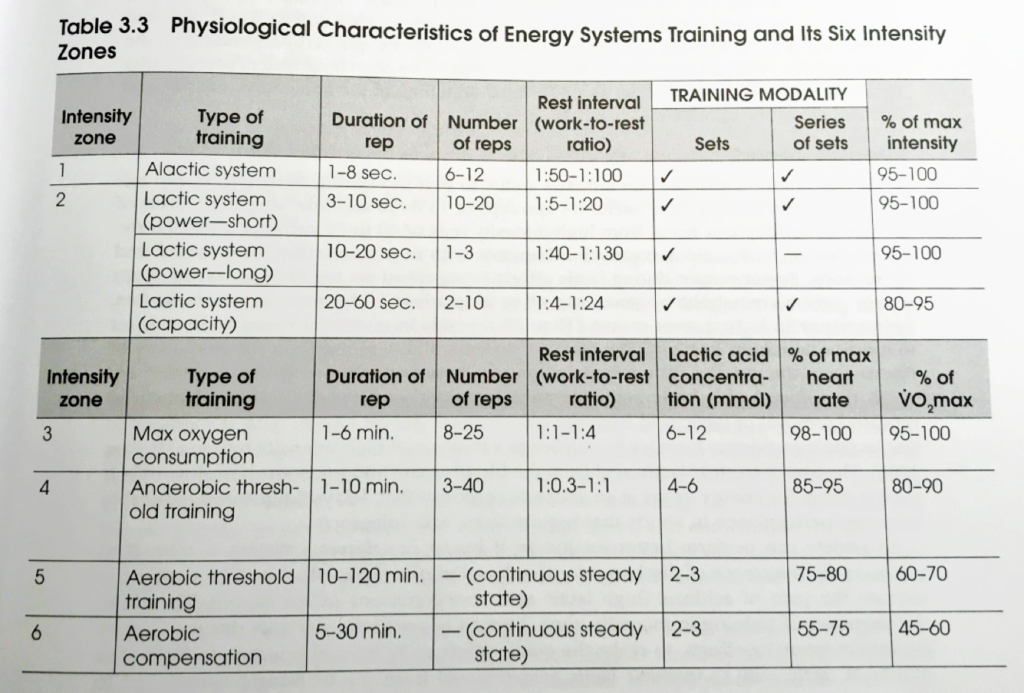Chapter 3, Training Physiology (Energy System Training)
Energy systems training is commonly underused in sport training regimens, primarily due to a lack of understanding, as well as misconceptions regarding its applicability to strength training. Bompa provides a remarkably accessible breakdown of how energy systems work and how they can be integrated into strength and conditioning for sport. Every coach should take into account the dominant energy systems used in the sport that they train for, and program accordingly, in order to see periodized success in their athletes.
To quickly summarize, athletes (and all people) need energy to perform, and that energy comes from the breaking down of a molecule called adenosine triphosphate (ATP) into adenosine diphosphate (ADP) and a phosphate.
The human body has three major ways of replenishing ATP when it has been used: the anaerobic alactic system (ATP-CP), the anaerobic lactic system, and the aerobic system. The ATP-CP system is the quick fix to muscle ATP depletion; it can supply energy for about 8-10 seconds of maximum effort, and is the dominant energy source used by sprinters and other explosive track and field events. The anaerobic lactic system uses glycogen (stored sugar) from the muscle and the liver to rebuild ATP in the muscle cells. This system can support bouts of about 10-60 seconds, and is primarily utilized in short distance runners and swimmers. The aerobic system uses oxygen in order to resynthesize ATP, and takes longer to kick in in comparison to the other energy systems. However, the aerobic system can support activities lasting from just over a minute to about three hours. Long-distance runners, wrestlers, and rowers use this system primarily.

How does all of this information inform programming for strength and conditioning? According to Bompa, different energy systems facilitate development in different types of strength training (recall from earlier chapters the strength-speed-power triangle/continuum). Bompa uses six intensity zones to describe the relationship between energy systems and strength training. Below are brief descriptions of each zone, followed by Table 3.3 from the book:
- ZONE 1: Trains Alactic (ATP-CP) System for acceleration, maximum speed, quick reaction, and fast, short performance of technical skills.
- ZONE 2: Trains Anaerobic Lactic System for adaptation to the nervous strain of longer maximum intensity efforts. Variations include lactic power short, lactic power long, and lactic capacity.
- ZONE 3: Trains Maximal Oxygen Consumption by promoting physiological adaptations to improve efficiency in oxygen transport and usage.
- ZONE 4: Trains Anaerobic Threshold to increase the intensity at which the rate of lactic acid build up in the blood equals the rate of removal; i.e. sustained maximal effort without using oxygen.
- ZONE 5: Trains Aerobic Threshold for enhanced cardiorespiratory and metabolic functioning that increases aerobic capacity.
- ZONE 6: Trains Aerobic Compensation for recovery, including removal of metabolites; i.e. dynamic rest.

As you read through and consider the individual components of each zone, think about how this can apply to your coaching, the sports team, the time of the season, and special considerations. Most important thing to consider is sports are played in a wide spectrum of energy systems; however, most games are won at the high end of energy output. Most programs should be built on correct foundational movement, slow controlled, quality executed, correct alignment based, and of significant intensity. Programming should be based on 2 basic targets that are compatible and then build from the ground up. In programming meso and macro cycles for developing each energy system should interrelate as programming for each training zone should be based on close training goals. It takes time to build a program to consider all these intensity zone, thus having an Annual plan to consider all targets in pivotal.
The last bits of the chapter provide some assistance with using these zones to create macro- and micro- plans. For both, coaches will want to look at the training phase of the athlete, and align that with the strength periodization phase that the athlete is at. From there, the appropriate energy systems training zone(s) can be determined and programmed for. The MorlandSTRENGTH blogging team would love to hear your questions and see your progress, so put some pens to paper and share with us what you come up with! Work on your Annual plan. Good luck, coaches!
Erin Blaser, NASM CPT
GWU SMHS DPT Class of 2020
NASM Certified Personal Trainer
Rockin’ Refuel BOGO Special! November 15-29!
Buy One Case, Get One FREE! $18 for TWO Cases (24 units)
Contact coach@morlandstrength.com to purchase
“The views, opinions, and judgments expressed in this message are solely those of the authors and peer reviewers. This content has been reviewed by a team of contributors but not approved by any other outside entity including the Roman Catholic Diocese of Raleigh.”






